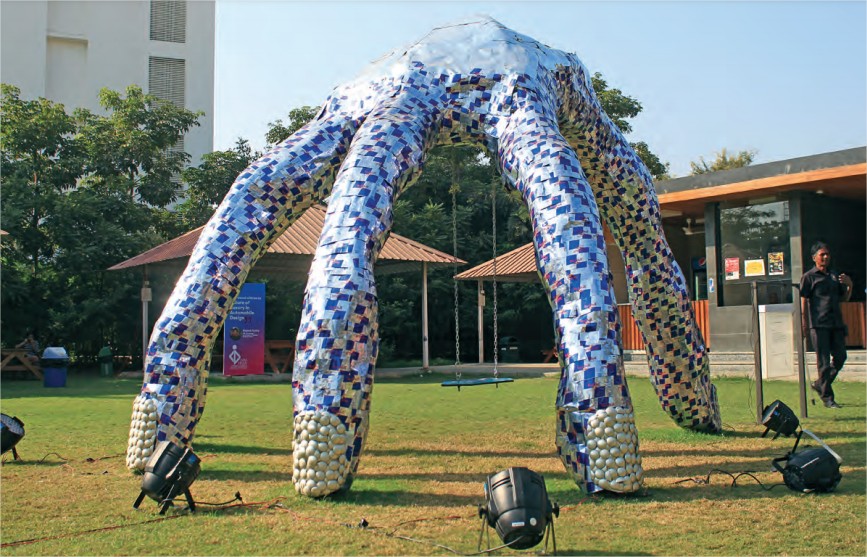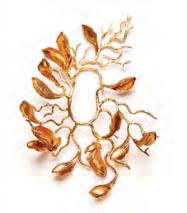At Ahmedabad’s 2018 India Design Confluence, REVATHI KANT, chief design officer at Tanishq Jewellery and jewel couturier PALLAVI FOLEY shared their success stories with an audience of over 4,000 students.
Whether you consider the centuries-old legacy of craftsmanship or a future directed by a sense of innovation, Ahmedabad has always been India’s design capital. The last week of November saw the 2018 India Design Confluence kick off at the UnitedWorld Institute of Design, unifying the design spectrum across all its platforms: art, architecture, graphics and animation, jewellery and crafts. Among a magnanimous list of speakers including Angela Guzman, design lead at Google, Rajesh Kutty, the lead interior designer at Bentley Motors, Uttam Pal Singh, the head at Discovery Kids, Rajeev Mishra, the principal of Sir J.J. College of Architecture and Manjri Vade, a celebrated contemporary artist, were two luminaries from the luxury jewel business, Pallavi Foley, a jewellery designer from Bangalore, and Revathi Kant, chief design officer at Titan Watches.
Addressing a veritable audience of over 4,000 design professionals and students, the industry experts advised the audience with tricks of the trade—what it takes to stay relevant in a competitive industry, standing out in an industry of aesthetics, and most importantly, why jewellery is more than just a superficial art of adornment.
Design Students: Diamonds In The Rough

While most convention speakers usually indulge in a one-way mode of communication, both Pallavi and Revathi were gregarious and made the youngsters aware that their engagement was crucial. Revathi asked the youngsters to interrupt her with their questions at any juncture in the hour-long lecture. Pallavi displayed images of her Indian Street neckpiece, which she had designed for De Beers when she was studying jewellery design at NIFT, and asked the participants to reinterpret the sketch for the new millennium. “The new generations of designers are grounded in the present. They are aware of how design shapes the world. I like the fact that they interpreted India in a very secular and non-religious way,” she said, as she chose her winners from the sketches they submitted.
“Design is still a relatively fledgling field of study in India. There is a great demand for talented designers to join the industry, but not as many graduates to fill the gap. I enjoy opportunities such as these, to interact with students, and offer them a holistic view of how the industry functions,” Revathi said.
Bling’s New Business Mantras
Nicknamed the Elsa Peretti of India by the World Gold Council, Pallavi Foley gravitates towards conversational pieces that are avantgarde. “The business is changing in a very design-centric way. The intrinsic value is always crucial, but today if you have an unusual piece, you can command a price. That is how the conservative Indian jewellery industry has changed. How long can you possibly wear a boring piece, if everyone has seen it?” she teases with sparkling wit.
Tanishq’s jewellery collections, on the other hand, have a more pan-Indian presence that takes its demographics into account.
With stores at most Indian cities, Revathi acknowledges that India still has a huge rural and small town population that is still rooted in tradition. “Rural India isn’t used to contemporising, so there is a dominant regional flavour that Tanishq embraces. Let’s take the mangalsutra, for example, it is still asked for as it was always made. At Tanishq, we have collections catering to all tastes.”
At the nascent stage of putting pen to paper and sketching a design, both agree that the millennial designer has to be tech savvy. “Design-wise, CAD interprets almost anything one can visualise. One has to understand the know-how of taking one’s jewellery online as compared to operating out of traditional brick – and-mortar boutiques. Jewellery e-tailers are now minting their worth in crores!” Pallavi stated.
Revathi analysed 3D jewellery printing as the next big thing that will take the business to the next level. “It’s an editive process and at Tanishq, we still haven’t ascertained its capacity but there’s immense potential. 3D printing is not restricted by the limitations of CNC machining and is able to produce parts that have in the past been impossible to make. Every jewellery business is now invested in mastering it,” she observed.
Bollywood Baubles
“I see a lot of meenakari jewellery dominating the bridal and festive season. Also, another notable trend is the evolution of the Indian solitaire with kundan work and uncut gems. I’ve channelled these historic craft techniques in my new collection Gulabo,” Pallavi revealed.
“A lot of international trends trickle down and get interpreted in the Indian context but Bollywood still rules the rung. Indian brides want imitations of what Sonal Kapoor, Anushka Sharma and Deepika Padukone wore at their own weddings, as part of their trousseau. The detail, intricacy and opulence of India’s ancient crafting techniques aren’t changing anytime soon. Indian brides still want to look like queens!” Revathi noted.
Dressing down and functionality remain the norm in the corporate space. “The Indian woman at work either wears fusion outfits or Western attire. Jewellery that conveys simplicity, minimalism and contemporaneity are more suited to work – these are the findings we have garnered from customers’ responses to Mia, a Tanishq collection catering to the working woman,” Revathi said.
Pallavi seconds that. “I see modularity emerging as a concept. The necklace I’m wearing right now can be worn in nine different ways, or can be cut and worn as a bracelet. Something lightweight that can be worn during the day but transforms effortlessly into evening wear—something that goes both ways!”
Golden Girls
Revathi started off her career as a marketing professional, but her love for aesthetics made her veer towards the business of design at Titan Watches, Tanishq’s parent company. “A chief design officer is still a young designation that is only appreciated by new-age businesses. Part of any overall business strategy utilises design these days, so having a designer in the boardroom offers an organisation a competitive edge,” she said.
Pallavi never imagined the magnitude her craft would take, when she studied jewellery design at NIFT, Delhi. “I always wanted to set up my own label. Whether it turned into a small or big studio, I wanted to create my own craft. That is all I knew back then.” she smiled, nostalgically.


